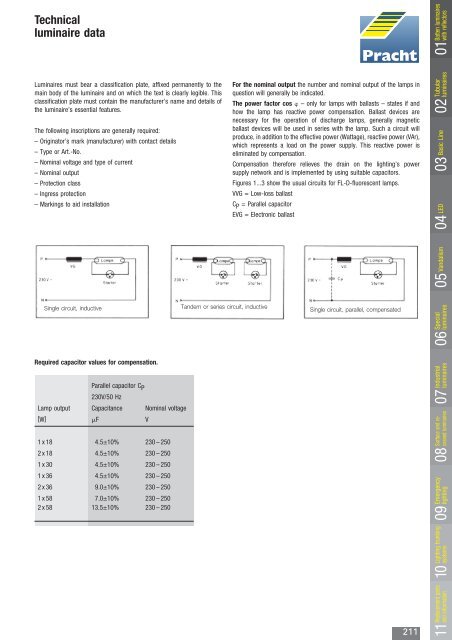Batten luminaires - Alfred Pracht Lichttechnik GmbH
Batten luminaires - Alfred Pracht Lichttechnik GmbH
Batten luminaires - Alfred Pracht Lichttechnik GmbH
Create successful ePaper yourself
Turn your PDF publications into a flip-book with our unique Google optimized e-Paper software.
Technical<br />
luminaire data<br />
Luminaires must bear a classification plate, affixed permanently to the<br />
main body of the luminaire and on which the text is clearly legible. This<br />
classification plate must contain the manufacturer’s name and details of<br />
the luminaire’s essential features.<br />
The following inscriptions are generally required:<br />
– Originator’s mark (manufacturer) with contact details<br />
– Type or Art.-No.<br />
– Nominal voltage and type of current<br />
– Nominal output<br />
– Protection class<br />
– Ingress protection<br />
– Markings to aid installation<br />
Single circuit, inductive<br />
Required capacitor values for compensation.<br />
Lamp output<br />
Parallel capacitor CP 230V/50 Hz<br />
Capacitance Nominal voltage<br />
[W] F V<br />
1 x 18 4.5±10% 230 – 250<br />
2 x 18 4.5±10% 230 – 250<br />
1 x 30 4.5±10% 230 – 250<br />
1 x 36 4.5±10% 230 – 250<br />
2 x 36 9.0±10% 230 – 250<br />
1 x 58 7.0±10% 230 – 250<br />
2 x 58 13.5±10% 230 – 250<br />
Tandem or series circuit, inductive<br />
For the nominal output the number and nominal output of the lamps in<br />
question will generally be indicated.<br />
The power factor cos – only for lamps with ballasts – states if and<br />
how the lamp has reactive power compensation. Ballast devices are<br />
necessary for the operation of discharge lamps, generally magnetic<br />
ballast devices will be used in series with the lamp. Such a circuit will<br />
produce, in addition to the effective power (Wattage), reactive power (VAr),<br />
which represents a load on the power supply. This reactive power is<br />
eliminated by compensation.<br />
Compensation therefore relieves the drain on the lighting’s power<br />
supply network and is implemented by using suitable capacitors.<br />
Figures 1...3 show the usual circuits for FL-D-fluorescent lamps.<br />
VVG = Low-loss ballast<br />
CP = Parallel capacitor<br />
EVG = Electronic ballast<br />
Single circuit, parallel, compensated<br />
211<br />
<strong>Batten</strong> <strong>luminaires</strong><br />
01with<br />
reflectors<br />
Tubular<br />
<strong>luminaires</strong><br />
02<br />
Basic Line<br />
03<br />
LED<br />
04<br />
Vandalism<br />
05<br />
Special<br />
<strong>luminaires</strong><br />
06<br />
Industrial<br />
<strong>luminaires</strong><br />
07<br />
Surface and recessed<br />
<strong>luminaires</strong><br />
08<br />
Emergency<br />
lighting<br />
09<br />
Lighting trunking<br />
systems<br />
10<br />
Replacement parts<br />
11and<br />
information














